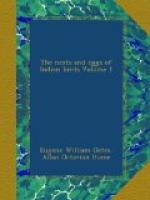Mr. Brooks says:—“It is like S. unicolor, but smaller, with shorter wing and more beautiful reflections. It is excessively abundant in Cashmere, at moderate elevations, and in the Valley, and breeds in holes of trees and in river-banks. The eggs are like those of S. vulgaris, but rather smaller. The latter bird[A] occurs plentifully in the plains of India in the cold weather, and is as profusely spotted as English specimens. The bills vary in length, and are not longer, as a rule, than those of British birds. I did not meet with S. vulgaris in Cashmere. It appears to migrate more to the west, for it is said to be common in Afghanistan. S. nitens also occurs in the plains in the cold season. I have Etawah specimens. They are at that time slightly spotted, but can always be very easily distinguished from S. vulgaris.”
[Footnote A: Mr. Brooks here refers to S. menzbieri.—ED.]
Mr. W. Theobald makes the following remark on its nidification in the Valley of Cashmere:—“Lays in the second and third weeks of May; eggs ovato-pyriform; size 1.15 by 0.85; colour, pale clear bluish green; valley generally, in holes of bridges, tall trees, &c., in company with Corvus monedula.”
Captain Hutton records that “S. vulgaris remains only during the coldest months, and departs as spring approaches: whereas the present species builds in the spring at Candahar, laying seven or eight blue eggs, and the young are fledged about the first week in May.”
The eggs of this species are generally somewhat elongated ovals, a good deal compressed towards one end, and not uncommonly more or less pyriform. They are glossy, but in a good light have the surface a good deal pitted. They are entirely devoid of markings, and seem to have the ground one uniform very pale sea-greenish blue. They appear to vary very little in colour, and to average generally a good deal smaller than those of the Common Starling.
They vary in length from 1.02 to 1.19, and in breadth from 0.78 to 0.87; but the average of twenty eggs is 1.13 by 0.83.[A]
[Footnote A: STURNUS PORPHYRONOTUS, Sharpe. The Central-Asian Starling.
This species breeds in Kashgharia, and visits India in winter. Dr. Scully writes:—“This Starling breeds in May and June, making its nest in the holes of trees and walls, and in gourds and pots placed near houses by the Yarkandis for the purpose. It seems to make only a simple lining for its hole, composed of grass and fibres. The eggs vary in shape from a broadish oval to an elongated oval compressed at one end; they are glossy and, in a strong light, the surface looks pitted. The eggs are quite spotless, but the colour seems also to vary a good deal—from a deep greenish blue to a very pale light sea-blue. In size they vary from 1.1 to 1.22 in length, and from 0.80 to 0.86 in breadth; but the average of nine eggs is 1.19 by 0.83.”]




